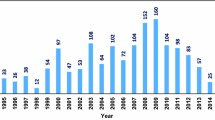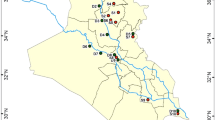Abstract
The winter fog in India is a recurrent phenomenon for more than a decade now affecting the entire Himalayan and sub-Himalayan regions covering an area of nearly 500,000 km2. Every winter (December–January), the air and surface transports in cities of northern India (Amritsar, New Delhi, Agra, Gwalior, Kanpur, Lucknow, and Allahabad) are severely disrupted with visibility reduced to <50 m at times. Since dust particles are known to act as nuclei for the fog formation, this study is aimed to carry out physicochemical characterization of the dust particulates accumulated during a protracted fog period from one of the severely fog affected cities of north India (Allahabad; 25°27′33.40″N–81°52′45.47″E). The dust-loaded tree leaves belonging to Ficus bengalensis and Ficus religiosa from 50 different locations between January 24 and 31, 2010 are sampled and characterized. The mass of dust, color, grain shape, size, phase constituents, and mineral magnetic parameters, such as magnetic susceptibility, SIRM, χ fd%, and S-ratio, show minor variation and the regional influence outweighs local anthropogenic contributions. The dust compositions show fractionated rare earth element pattern with a pronounced negative Eu anomaly similar to upper continental crust and further suggesting their derivation from sources located in parts of north and central India.









Similar content being viewed by others
References
Abdul-Razzaq, W., & Gautam, M. (2001). Discovery of magnetite in the exhausted material from a diesel engine. Applied Physics Letters, 78, 2018–2019.
Ali, K., Momin, G. A., Tiwari, S., Safai, P. D., Chate, D. M., & Rao, S. P. (2004). Fog and precipitation chemistry at Delhi, North India. Atmospheric Environment, 38, 4215–4222.
Biswas, K. F., Ghauri, B. M., & Husain, L. (2008). Gaseous and aerosol pollutants during fog and clear episodes in South Asian urban atmosphere. Atmospheric Environment, 42, 7775–7785.
Blaha, U., Sapkota, B., Apple, E., Stanjek, H., & Rosler, W. (2008). Micro-scale grain-size analysis and magnetic properties of coal-fired power plant fly ash and its relevance for environmental magnetic pollution studies. Atmospheric Environment, 42, 359–837.
Bloemendal, J., King, J. W., Hall, F. R., & Doh, S. J. (1992). Rock magnetism of Late Neogene and Pleistocene deep sediments: relationship to sediments source, genetic process and sediments lithology. Journal of Geophysical Research, 97, 4361–4375.
Cereceda, P., Larrain, H., Osses, P., Farías, M., & Egaña, I. (2008). The spatial and temporal variability of fog and its relation to fog oases in the Atacama Desert, Chile. Atmospheric Research, 7, 312–323.
Charlesworth, S. M., & Lees, J. A. (1997). The use of mineral magnetic measurements in polluted urban lakes and deposited dusts, Coventry, UK. Physics and Chemistry of the Earth, 22, 203–206.
Chaurasia, S., Sathiyamoorthy, V., Paul Shukla, B., Simon, B., Joshi, P. C., & Pal, P. K. (2011). Night time fog detection using MODIS data over Northern India. Meteorological Applications, 18(4), 483–494.
Chen, F. H., Yang, L. P., Wang, J. M., & Zhang, J. W. (1999). Study on atmospheric particulate pollution of Lanzhou using magnetic measurements. Journal of Environmental Science, 11(3), 73–77.
Choudhury, S., Rajpal, H., & Saraf, A. K. (2007). Mapping and forecasting of North Indian winter fog: an application of spatial technologies. International Journal of Remote Sensing, 28(16), 3649–3663.
Dunlop, D. J. (1973). Superparamagnetic and single domain threshold sizes in magnetite. Journal of Geophysical Research, 78, 780–1793.
Dunlop, D. J., & Ozdemir, O. (1997). Rock magnetism: fundamentals and frontiers. Cambridge: Cambridge University Press.
Evans, M. E., & Heller, F. (2003). Environmental magnetism. Principles and applications of enviromagnetics (p. 99). San Diego: Academic Press.
Flanders, P. J. (1994). Collection, measurements and analysis of airborne magnetic particulates from pollution in the environment. Journal of Applied Physics, 5, 931–5936.
Gautam, P., Blaha, U., & Apple, E. (2005). Magnetic susceptibility y of dust-loaded leaves as a proxy of traffic-related heavy metal pollution in Kathmandu City, Nepal. Atmospheric Environment, 39, 2201–2211.
Goddu, S. R., Appel, E., Jordanova, D., & Wehland, R. (2004). Magnetic properties of road dust from Vishakhapatnam (India)—relationship to industrial pollution and road traffic. Physics and Chemistry of the Earth, 9, 985–995.
Hanesch, H., & Scholger, R. (2002). Mapping of heavy metal loadings in soil by means of magnetic susceptibility measurements. Environmental Geology, 42, 857–870.
Hanesch, H., Scholger, R., & Rey, D. (2003). Mapping dust distribution around an industrial site by measuring parameters of tree leaves. Atmospheric Environment, 37, 5125–5133.
Hoffmann, V., Knab, M., & Appel, E. (1999). Magnetic susceptibility mapping of roadside pollution. Journal of Geochemical Exploration, 6, 13–326.
http://en.wikipedia.org/wiki/Allahabad. Accessed 20 December 2011.
http://IITRoorkee/IITRoorkee . Accessed on 20 December 2012.
Jenamani, R. K., & Tyagi, A. (2011). Monitoring fog at IGI Airport and analysis of its runway-wise spatio-temporal variations using meso-RVR network. Current Science, 100, 491–501.
Lorenzini, G., Grassi, C., Nali, C., Petiti, A., Loppi, S., & Tognotti, L. (2006). Leaves of Pittosporum toriba as indicators of airborne trace element and PM10 distribution in central Italy. Atmospheric Environment, 40, 4025–4036.
Lu, S. G., Bai, S. Q., & Xue, Q. F. (2007). Magnetic properties as indicators of heavy metals pollution in urban topsoils: a case study from the city of Luoyang, China. Geophysical Journal International, 171, 68–580.
Lu, S. G., Zheng, Y. W., & Bai, S. Q. (2008). A HRTEM/EDX approach to identification of the source of dust particles on urban tree leaves. Atmospheric Environment, 42, 431–6441.
Maher, B. A., Moore, C., & Matzka, J. (2007). Spatial variation in vehicle-derived metal pollution identified by magnetic and elemental analysis of roadside tree leaves. Atmospheric Environment, 42, 364–373.
Moreno, E., Sagnotti, L., Turell, J. D., Winkler, A., & Cascella, A. (2003). Biomonitoring of traffic air pollution in Rome using magnetic properties of tree leaves. Atmospheric Environment, 7, 2967–2977.
Muxworthy, A. R., Schmidbauer, E., & Petersen, N. (2002). Magnetic properties and Mossbauer spectra of urban atmospheric particulate matter: a case study from Munich, Germany. Geophysical Journal International, 150, 558–570.
Oldfield, F., Hunt, A., Jones, M. D. H., Chester, R., Dearing, J. A., Olsson, L., et al. (1985). Magnetic differentiation of atmospheric dusts. Nature, 317, 516–518.
Pant, V., Deshpande, C. G., & Kamra, A. K. (2010). Changes in concentration and size distribution of aerosols during fog over the south Indian Ocean. Journal of Earth System Science, 119, 479–487.
Pati, J. K., Reimold, W. U., Koeberl, C., & Pati, P. (2008). The Dhala structure, Bundelkhand Craton, Central India—eroded remanant of a large Paleoproterozoic impact structure. Meteoritics and Planetary Science, 43, 1383–1398.
Petrovsky, E., & Ellwood, B. B. (1999). Magnetic monitoring of pollution of air, land and water. In B. A. Maher & R. Thomposon (Eds.), Quaternary climates, environments and magnetism (pp. 279–322). Cambridge: Cambridge University Press.
Power, L. A., Worsley, T. A., & Booth, C. (2009). Magneto-biomonitoring of intra-urban spatial variations of particulate matter using tree leaves. Environmental Geochemistry and Health, 31, 315–325.
Prajapati, S. K., & Tripathi, B. D. (2008). Management of hazardous road derived respirable particulates using magnetic properties of tree leaves. Environmental Monitoring and Assessment, 139, 351–354.
Prasad, A. K., & Singh, R. P. (2007). Comparison of MISR-MODIS aerosol optical depth over the Indo-Gangetic basin during the winter and summer seasons (2000–2005). Remote Sensing of Environment, 107, 109–119.
Rashid, S. A. (2005). The geochemistry of Mesoproterozoic clastic sedimentary rocks from the Rautgara Formation, Kumaun Lesser Himalaya: implications for provenance, mineralogical control and weathering. Current Science, 88(11), 1832–1836.
Raza, M., Khan, A., Bhardwaj, V. R., & Rais, S. (2012). Geochemistry of Mesoproterozoic sedimentary rocks of upper Vindhyan Group, southeastern Rajasthan and implications for weathering history, composition and tectonic setting of continental crust in the northern part of Indian shield. Journal of Asian Earth Sciences, 48, 160–172.
Saraf, A. K., Bora, A. K., Das, J., Rawat, V., Sharma, K., & Jain, S. K. (2011). Winter fog over the Indo-Gangetic Plains: mapping and modeling using remote sensing and GIS. Natural Hazards, 201(58), 199–220.
Shu, J., Dearing, J. A., Morse, A. P., Yu, L. Z., & Li, C. Y. (2000). Magnetic properties of daily sampled total suspended particulates in Shanghai. Environmental Science & Technology, 34, 2393–2400.
Singh, V. K., Gupta, T., Tripathi, S. N., Jariwala, C., & Das, U. (2011). Experimental study of the effects of environmental and fog condensation nuclei parameters on the rate of fog formation and dissipation using a new laboratory scale fog generation facility. Aerosol and Air Quality Research, 11, 140–154.
Spassov, S., Egli, R., Heller, F., Nourgaliev, D. K., & Hannam, J. (2004). Magnetic quantification of urban pollution sources in atmospheric particulate matter. Geophysical Journal International, 59, 555–564.
Sun, S. S., & McDonough, W. F. (1989). Chemical and isotopic systematics of oceanic basalts: implications for mantle composition and processes. Geological Society London Special Publications, 42, 313–345.
Thompson, R., & Oldfield, F. (1986). Environmental magnetism. London: Allen & Unwin. ISBN-0–04–538003, 277.
Tiwari, S., Payra, S., Mohan, M., Verma, S., & Bisht, D. S. (2011). Visibility degradation during foggy period due to anthropogenic urban aerosol at Delhi, India. Atmospheric Pollution Research, 2, 116–120.
Tomaˇsevi’c, M., Vukmirovic’, Z., Rajsˇic’, S., Tasic’, M., & Stevanovic’, B. (2005). Characterization of trace metal particles deposited on some deciduous tree leaves in an urban area. Chemosphere, 61, 753–760.
Wong, C. S. L., Li, X. D., & Thornton, I. (2006). Urban environmental geochemistry of trace metals. Environmental Pollution, 142, 1–16.
Yang, L. P., & Chen, F. H. (2002). Chemical characteristics of atmospheric dust in Lanzhou. Acta Scientiae Circumstantiae, 22(4), 499–502.
Acknowledgments
The authors gratefully acknowledge the Deputy Director General (NR), Geological Survey of India, Lucknow for the REE analyses, and the PLANEX, PRL, Department of Space, Government of India, (Ahmedabad) for electron probe microanalyzer analyses used in the present study, respectively. The GIS facilities kindly provided to JKP through the GRBM project, MoE&S, Government of India is also thankfully acknowledged.
Author information
Authors and Affiliations
Corresponding author
Rights and permissions
About this article
Cite this article
Chakarvorty, M., Pati, J.K., Patil, S.K. et al. Physical characterization, magnetic measurements, REE geochemistry and biomonitoring of dust load accumulated during a protracted winter fog period and their implications. Environ Monit Assess 186, 2965–2978 (2014). https://doi.org/10.1007/s10661-013-3594-4
Received:
Accepted:
Published:
Issue Date:
DOI: https://doi.org/10.1007/s10661-013-3594-4




